Abbot Academy
Abbot Academy (also known as Abbot Female Seminary and AA) was an independent boarding preparatory school for women boarding and day students in grades 9–12 from 1828 to 1973.[3] Located in Andover, Massachusetts, Abbot Academy was notable as one of the first incorporated secondary schools for educating young women in New England.[1][4] It merged with Phillips Academy in 1973[5][6] and campus buildings along School Street continue to be used for the combined school. Some Abbot traditions continue at the combined private boarding school such as Parents' Weekend.[7] Since the 40th anniversary in 2013 of the merger of the two schools, there has been renewed interest in Abbot's history and traditions.[8]
| Abbot Academy | |
|---|---|
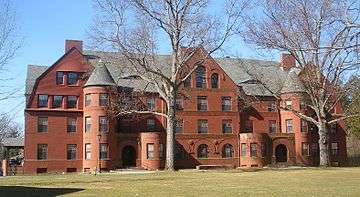 | |
| Location | |
 Abbot Academy  Abbot Academy | |
| , United States | |
| Coordinates | |
| Information | |
| Type | Independent, Boarding |
| Motto | Facem Praetendit Ardentem (She Holds Aloft a Burning Torch) |
| Established | 1829[1] |
| Closed | 1973 (merged with Phillips Academy) |
| Principal | Donald Gordon |
| Grades | 9–12 |
| Gender | Girls |
| Average class size | 115 seniors (1973)[2] |
| Campus | Suburban |
| Color(s) | Light blue and white |
| Nickname | Abbot Rabbits |
| Website | www |
History
| Those persons who feel favorably disposed toward the establishment of a FEMALE HIGH SCHOOL in the South Parish of Andover, are requested to meet at Mr. James Locke's, on Tuesday evening next, the 19th inst., at 6 o'clock, P.M. |
| Notice on trees and buildings around Andover, February 15, 1828. Source: Susan Lloyd[9] |
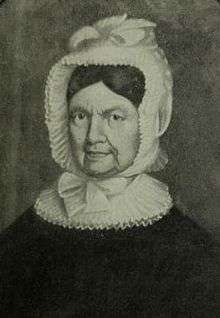
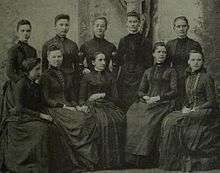

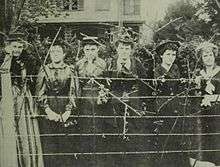
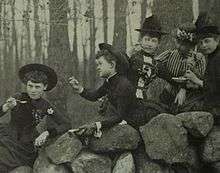
The school was founded during a time when the prevailing view was that women's education "should always be relative to men", with some believing that study of "higher subjects" such as philosophy and mathematics might render women to be infertile.[9] One of the first formal discussions to propose a school for young women happened on February 19, 1828.[10] The school was incorporated in 1829 with 70[4] or 85[10] pupils from eighteen to twenty years of age for the "exclusive work of educating women". According to one source, the official opening day was May 6, 1829.[4]
...to regulate the tempers, to improve the taste, to discipline and enlarge the minds and form the morals of youth...
— Abbot Constitution, 1829[1]
The early years
The school received financial support from Sarah Abbot who pledged substantial money, which allowed for loans to begin construction; Sarah Abbot died in 1850 and left a substantial sum for educational purposes.[10] After mid-century, Abbot faced several challenges: the addition of a public high school in Andover, followed by the challenges of coping with the American Civil War.[9] In 1853, the first principalship was offered to a woman, and additional monies were raised for the construction of dormitories.[10] In 1859, the "strong-willed" but "ideologically moderate" McKeen sisters — headmistress Philena and Phebe—exerted strong leadership by adopting a "school-home" approach.[9] The years were marked by substantial expansion of buildings.[9] The McKeens fostered the study of French and German and introduced a "systematic oral language program" on a par with that of Harvard University and which "far outdistanced Phillips Academy", which did not offer any modern language instruction until the mid 1870s.[9] Under their "no-nonsense" leadership, teachers stayed longer, many for ten or more years.[9]
Abbot had always promised order, but the McKeen sisters delivered it in spades. They loved schedules. Up at 6:00, breakfast at 6:30, clean your room——and perhaps a teacher's parlor as well. Though four Irish maids also helped out at $1.98 a week, the McKeens considered house work part of education ... Miss McKeen might ask a girl to help her change guest beds, questioning her the while on Butler's Analogy. Between 8:00 and 9:00 a.m. older students often climbed the Hill for a Geology lecture while younger ones did their daily calisthenics, but all must be on hand for the Devotions that formally opened the school day. Before mid-day dinner everyone wore gym suits with pantaloons, and skirts ten inches from the ground. ... Recitations continued till 3:30, then came Recreation Hours, with time for walking in pairs, studying, mending, croquet, or (after 1886) tennis. Supper followed; the evening was an alternation of study hours, "half-hours" for individual meditation ... and "quarters" for room-to-room visiting. Evening Devotions might mean anything from a hymn sing to a prayerful scolding. Bed at 10:00.
— Susan McIntosh Lloyd, in A Singular School[9]
It was during the late 1800s that the school had a "golden age", according to one view.[1] The campus was visited by luminaries such as Helen Keller and her teacher Anne Sullivan and Amos Bronson Alcott.[1] The leadership of Philena and Phebe McKeen was characterized by substantial fundraising and growth.[1] According to Susan McIntosh Lloyd, Abbot's curriculum "may have surpassed that of Phillips" during these years.[1] After 1910, the only structures built were "gates".[1] The school was like a "family" but commanded by women, in which "women and girls could enjoy one another as persons without self-consciousness or shame."[9]
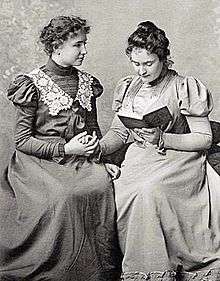
Abbot's women and girls ... One thinks of Victorian women as confined, and so they were. They could not openly initiate friendship with boys or men; they were expected to hide their interest in sex or to subsume it within coquettish formulae, no matter how interested they really were. Partly because of this relative isolation from men, however, loving, lasting friendships between women could quietly thrive, modeled often on the close mother-daughter or sister-sister relationships that existed apart from men's affairs.
— Susan McIntosh Lloyd, in A Singular School[9]
Art education
The academy emphasized art education. After starting a small art club in 1871 led by Professor E. A. Park, the academy introduced one of the nation's first History of Art courses in 1873.[11][12] Painting and drawing were taught by professional painter and alumnus[13] Emily A. Means who had studied with well-known painters in Europe for four years.[12][14] Means guided the art department from 1877 to 1892 and later served as principal from 1898 to 1911.[15][16][17]
The 1930s through the 1960s
The school went through challenging times during the Great Depression of the 1930s.[9] In the Depression's first five years, the school lost approximately $60,000 annually as well as a sharp drop in its real-estate assets, and the school slipped from having 135 boarders in 1929–30 to 71 boarders in 1933–34.[9] Despite financial concerns, the school continued to dismiss "unruly or lazy students" or those who tucked "dummies into their beds" to spend the night at Phillips Academy.[9] Many other schools folded during the Depression years.[9] During these years, the school taught the "basic college preparatory" program of 3 years of English, 5 years of languages (including 2 or 3 of Latin), 2 or 3 years of mathematics, 1 year of science and 1 year of history, as well as physical education, an "all school choral class" and Bible study of one hour a week, but requirements adjusted over time, largely dictated by preferences of college admissions departments.[9] From World War II and afterwards, the academy experienced increasing enrollment; ten years after the attack on Pearl Harbor, a third of its teachers were either European born or European educated.[9] The school opened its doors more widely to minority groups, such as African American women and Jews.[9]
Academic excellence improved. An alumna, Elizabeth Thomas '49, recalled her Abbot teaching as "the best she has ever had", with college being easier.[9] However, during these years, there was a greater space between teachers and students, such that there were no "out-of-class relationships" between them; teachers seemed "miles away" unless they were enforcing rules about lipstick or patrolling the Phillips campus for errant women or checking mail for return addresses to "certain Phillips boys."[9] Rules forbade smoking and drinking and sexual activity; one 1954 alumna described a "whole system of deception" designed to evade teachers, seen as "the enemy," with deceptions done to get messages to Phillips students, sometimes through day student intermediaries or by messages left in bushes.[9]
Why was the faculty so intent on having the school go on in that crazy old fashioned way? ... Abbot was the only place I'd heard of in 1949 where 1849 was still preserved.
— Elizabeth Marshall, quoted in A Singular School.[9]
However, some students appreciated that the rules cleared "time and space for that peaceful collection of self".[9] Nevertheless, applications to the school increased from the 1950s through the 1960s.[9] During the 1960s, the ratio of applicants to acceptances was three to one.[9] The 1960s featured rules easing somewhat, with more chaperoned dances, more phone calls and dating as well as "cattle-market mixers", but the easing sometimes encouraging girls to find "ways to be still naughtier."[9] Lloyd described the coming changes:
No school is an island: before 1960, every chapter of Abbot's story had been bound in some degree to the realities and dreams of the larger society. ... the old Abbot had made itself a place apart, especially after the McKeen sisters came, and it did its best to remain so through the early 1960s. During the final decade, the outside world beat upon Abbot's doors with such insistence that they must either be opened up or broken down. The Trustees opened them and the world rushed in like a clumsy repairman, knocking over tables and trampling valuable heirlooms, but also bringing fresh air into musty places, and piling on the floor a heap of lumber and tools with which to build anew.
— Susan Lloyd, in A Singular School.[9]
According to Lloyd, Abbot Academy seemed to be a "nineteenth century school" which was stagnant and insular and limited in comparison with the abrupt societal changes made during the 1960s.[9] In 1967, there were greater ties between Phillips Academy and Abbot, including a Phillips-Abbot committee to explore a "wide range of shared activities" between the two schools.[9] Abbot trustee Philip Allen had determined that both schools should merge, but that this was a "hidden agenda"; Allen brought in headmaster Donald Gordon, a graduate of Phillips Academy and Yale, to bring "Abbot up to the point where it could be part of Phillips Academy."[9][9] Abbot's "old dress code" was abolished for a "neat and clean" requirement.[9] The 1969-70 year was "tumultuous" nationwide, with student revolts on many college campuses and foreign policy failures abroad.[9] The following is a description of Abbot campus life in 1969:[9]
Touch football players romped on the sacred Circle. Not a saddle shoe was to be seen; indeed, one boy and two girls played with no shoes at all, in spite of November. Two pairs of faded blue jeans wandered by, one belted in macrame and filled by a man of bristling beard; he was discussing English papers with the other.
— Susan Lloyd in A Singular School[9]
The 1973 merger
The late 1960s and early 1970s was marked by the merger between the two schools. The merger was brought about by many factors, including the sense of shared history and goals between the two schools, common activities, plus survey research showing that 94% of students in northeastern secondary schools wished for coeducation.[9] The times "favored coeducation"; in 1968, 53 colleges and universities either became coeducational or began coordinate instruction.[9] While Phillips Academy "held the cards" regarding whether the two schools should merge, there was a "crasser impetus" from admissions statistics, as Phillips was increasingly being turned down by applicants preferring newly-coeducational competitors such as St. Paul's, Taft, Northfield-Mount Hermon, and Exeter.[9] Many committee meetings, including discussions between administrators and teachers, happened over a sixteen-month period.[9] The Phillips headmaster, John Kemper, who had kinship ties with women graduates of Abbot, felt a merger was "practical, ethical, and educationally sound", although several times the Phillips Board of Trustees refused to sanction a merger.[9] The school merged with Phillips Academy on June 28, 1973.[4] Many Abbot traditions were included in the combined school, such as having a designated weekend in the fall for parents to visit.
Parents’ Weekend was Abbot’s response to formalize parent visits to the school. In the past, parents would visit the school on many different occasions. The event created one specific weekend for all parents to visit.
— Tim Sprattler, 2009[7]
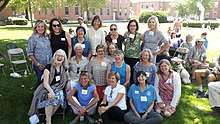
After the merger, $1 million of Abbot's endowment became the basis for the Abbot Academy Association, which funds various educational programs and projects submitted by students, faculty, and staff.[18][19][20] Since the first Abbot Grant was awarded in the fall of 1973, nearly 2000 Abbot Grant proposals have been submitted by students and members of the faculty, staff and administration of Phillips Academy. The Abbot Academy Association has funded more than 1400 of these proposals with grants totaling $9,400,000.[21] In 2014, the Abbot Academy Association's endowment had grown to $10 million.[22]
Campus life
Activities included the Fidelio Chorus, school government, and the school newspaper. Athletic programs included basketball, crew,[23] cycling, ballet and modern dance, fencing, soccer, softball, and tennis. In the late 1960s, Abbot's math department set up a paper-tape terminal connected to a computer at Merrimack College in North Andover, Massachusetts. This provided the high school students with early BASIC-language computer programming skills. In 1973, the languages taught included English, French, German, Latin, Russian, and Spanish.[24]
Academic prizes
Abbot was a chapter member of the Cum Laude Honor Society. The school awarded the following student prizes annually:[25]
|
|
The Madame Sarah Abbot award was established through a gift from the Abbot Class of 1973. The award is given to a female Phillips Academy senior who " … best exemplifies 'strong character, effective leadership and outstanding scholarship.'"[26]
School publications
In June 1873, the first issue of the Abbot Courant was published. This student literary magazine appeared two to three times a year.[27] Later editions included art work and photographs. In 1992, with a grant from the Abbot Academy Association, the Courant was revived at Phillips Academy and continues to be published twice a year. In 2002, a 123-page alumni edition was published.[28] The Abbot Academy yearbook was published from 1900 to 1973. Originally known as The Abbot Academy Class Book, the yearbook became The Circle in 1916 (this is the first year that the double-A logo used on senior class rings appeared on the book cover).[29][30] Digital versions of the Abbot Courant and The Circle are available through the school Archives and Special Collections.[31]
The student newspaper was called Cynosure. In 1974, it moved to Phillips where it became a monthly magazine.[32]
Traditions
Students were divided into two groups called Gargoyles and Griffins for sports teams and for other purposes that required dividing the students into groups; their colors were green and orange, respectively.[33] Dual-color felt beanie hats with an image of a gargoyle or griffin were distributed to students.
The locally based Clan MacPherson Pipes and Drums led graduation processions on the Abbot Circle.[34] This tradition continues today at Phillips Academy.[35] At graduation, after chapel, Seniors and Junior Middlers (eleventh graders) met in the Senior Courtyard for the Ring Ceremony. (This central garden was completely enclosed by the three sides of Draper Hall with the dining room wall as the fourth side.) By tradition, Junior Mids who purchased Abbot Academy class rings the year before wore them with the "AA" insignia upside-down. During the Ring Ceremony, each Junior Mid received a Senior sponsor. The Junior Mid, now recognized as a member of the new Senior class, turned her ring so that the insignia was upright. In 1973, all students who wanted to were allowed to buy Abbot class rings.[36]
Buildings and campus
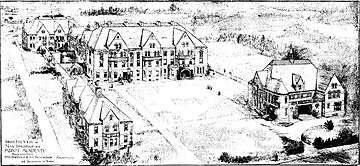
In 1863, the Abbot campus consisted of one acre surrounded by a fence. By 1878, it was approximately 22 acres.[38] Abbot's three main buildings (Abbot Hall, Draper Hall, and McKeen Hall) are listed on the National Register of Historic Places.[39] The first academy building, Abbot Hall, is an "exceptional" early example of the Greek Revival style. It was built in 1828–29.[40] Since 1996, it has housed Phillips Academy's Brace Center for Gender Studies.[41] An art gallery was added to the left side of Abbot Hall in 1906–07. It was designed by Andrews, Jacques, & Rantoul of Boston. The art gallery housed the collection of Mrs. Esther Byers.[42] The Merrill Memorial Gates and two side gates (the John P. Taylor and George G. Davis gates) were added in 1921 to the front and sides, respectively, of the Abbot Circle. Designed a few years earlier by the firm of McKim, Mead & White, similar gates appear at Harvard University, Princeton University, and Bowdoin College.[43] The Abbot Circle, around which the main buildings are grouped, was re-dedicated on 3 May 1997.[37] The tree-lined Maple Walk, which once connected the dining room at the back of Draper Hall with Phillips Street, remains in use. (The dining room was demolished.)[44]
Headmasters and headmistresses
School principals:[45]
|
|
For further information, consult The Philippian:[47]
Distinguished alumnae and faculty
Notable alumnae
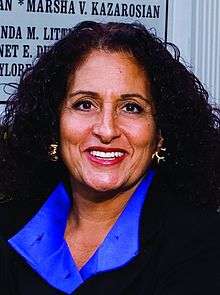
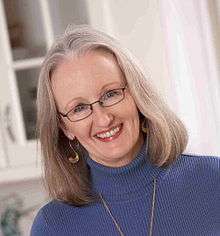
- Julia Alvarez (1967) - Poet, novelist, essayist[49]
- Julia Constance Fletcher - (1867)
- Harriette Newell Woods Baker (1833) - Story book author[49]
- Alice Stone Blackwell (1867) - Editor Woman's Journal, activist, and translator[50]
- Anna Brackett - Philosopher, educator
- Charlotte Emerson Brown - Clubwoman
- Maria Susana Cummins (1845) - Author of international bestseller; domestic fiction writer[50]
- Wendy Ewald (1969) - Photographer and educator, MacArthur Fellowship winner[51]
- Mary H. Graves - Unitarian minister, literary editor, writer[52]
- Marsha Kazarosian (PA 1974) - Attorney
- Lucy R. Lippard (1954) - Art theorist[49]
- Priscilla Martel (PA 1974) - Chef and cookbook author[53]
- Sara Nelson (PA 1974) - Former editor-in-chief of Publishers Weekly
- Elizabeth Marshall Thomas (1949) - Anthropologist[49]
- Elizabeth Stuart Phelps Ward (1858) - Early feminist author[50]
- Kate Douglas Wiggin (1873) - Author of Rebecca of Sunnybrook Farm[54]
- Francesca Woodman - Photographer[50]
For additional alumnae, consult Notable Alumni: Long List:[55]
Notable faculty
- Emily Hale, speech and drama, muse of T.S. Eliot
- Maud Morgan
See also
- Hartwell and Richardson architects
- Phillips Academy
Suggested reading
- Susan McIntosh Lloyd. "A Singular School: Abbot Academy 1828-1973", Hanover, NH: Published by Phillips Academy, Andover, 1979.
- Susan J. Montgomery and Roger G. Reed. "The Campus Guide. Phillips Academy Andover", New York: Princeton Architectural Press, 2000.
- Philena McKeen (Headmistress) - author.
- Massachusetts Board of Education; George A. Walton (1877), "Report on Academies: Abbot Female Academy", Annual Report...1875-76, Boston – via Internet Archive
References
- Francesca Balboni, Andover Historical Society, Andover Townsman, March 17, 2011, Andover Stories: Abbot Academy a leader in its own right for 150 years, Accessed Aug. 10, 2013
- "The Abbot Forum", Abbot Academy, Vol. IV, No. 2, June 1973, p. 22.
- NY Times, NEEDS OF THE ABBOT ACADEMY.; ALUMNAE TRYING TO RAISE $150,000 FOR NEW BUILDINGS, Accessed August 10, 2013, "... the female university at Andover, Mass"
- Susan McIntosh Lloyd, 1979, A Singular School: Abbot Academy, 1828-1973, Accessed Sept. 6, 2013, “... One of the first educational institutions in New England to be founded for girls and women alone, Abbot had by far the longest corporate life of any ...”
- Jonathan Phelps, Lawrence Eagle-Tribune, October 14, 2013, Addison draws attention to Innu exhibit with large banners, Accessed Aug. 10, 2013
- Amanda Bergeron, Boston Globe, Sept. 6, 2007, Barbara Sisson, retired teacher active in arts, Accessed Aug. 10, 2013, "... Abbot Academy, a boarding school for girls in Andover... 1973, when the school became part of Phillips Academy, Andover ..."
- Alex Salton, thephilippianonline, October 26, 2009, Parents’ Weekend Tradition Began with Abbot Academy, Accessed Aug. 10, 2013.
- "Calling all Alumni from the late '60s to the late '70s!" in Andover the Magazine of Phillips Academy, Spring, 2013, p. 57.
- Source: Susan M. Lloyd, 1979, A Singular School: Abbot Academy, 1828-1973, Accessed Sept. 6, 2013
- Annie Sawyer Downs, New England Magazine, 2011, Abbot Academy Archived March 2, 2014, at the Wayback Machine, Accessed August 10, 2013.
- Douglas C. Allen. "United States of America: Art Education". Grove Art Online.
- Deborah Barker (2000). Aesthetics and Gender in American Literature: Portraits of the Woman Artist. Bucknell University Press. pp. 213–. ISBN 978-0-8387-5408-5.
- Note: class of 1869
- Journal of Education. Boston University, School of Education. 1898. pp. 268–.
- John William Leonard; Albert Nelson Marquis (1910). Who's who in America. Marquis Who's Who. pp. 2354–.
- Katharine Roxanna Kelsey (1929). Abbot Academy Sketches, 1892-1912. Houghton Mifflin.
- "Educational Intelligence". Journal of Education. 19 (1829): 526–531. 11 May 1911. JSTOR 42821783.
- https://www.andover.edu/About/AbbotAcademyAssociation/Pages/GuidelinesforGrantProposers.aspx
- Abbot Academy Association
- February 1, 2013, Boston.com, Andover Welcomes Best-selling Author Reza Aslan, Accessed Aug. 10, 2013, "...funded by the Abbot Academy Association."
- https://www.andover.edu/About/AbbotAcademyAssociation/GrantHistory/Pages/default.aspx
- Loren Gary, "A Widening Circle: Abbot Academy and the Abiding Significance of Place", Andover: Phillips Academy, 1997, p. 7.
- Note: through Phillips Academy
- "The Abbot Forum", Abbot Academy, 1973, p. 9.
- The Abbot Forum", Abbot Academy, 1973, pp. 36, 37.
- The Phillipian, Vol. CV, No. 25, June 3, 1984, p. 1.
- The Abbott Courant, Vol. 1, No. 1, June 1873.
- The COURANT, Alumni Edition: 10 Years, Phillips Academy Andover, Fall 2002, p. [6].
- Class Book: Published by the ... Senior Class of Abbot Academy, Andover, Massachusetts.
- The Abbot Circle Nineteen Hundred and Sixteen, Senior Class of Abbot Academy, Andover, Massachusetts.
- Abbot Academy Archives and Special Collections: Phillips Academy Andover
- "The Abbot Forum", Abbot Academy, 1973, p. 25.
- Susan McIntosh Lloyd. "A Singular School: Abbot Academy 1828-1973", p. 234.
- Clan MacPherson Pipes and Drums
- "Class of 2013 graduates from Phillips Academy", http://www.andover.edu/about/newsroom/pages/commencement2013.aspx
- The Abbot Forum, Vol. IV, Number 2, June 1973, p. 30.
- Loren Gary, "A Widening Circle: Abbot Academy and the Abiding Significance of Place", Andover: Phillips Academy, 1997, p. 14.
- Susan J. Montgomery and Roger G. Reed. "The Campus Guide. Phillips Academy Andover", New York: Princeton Architectural Press, 2000. pp. 98–9.
- Loren Gary, "A Widening Circle: Abbot Academy and the Abiding Significance of Place", Andover: Phillips Academy, 1997, p. 5.
- Quote from Montgomery and Reed. "The Campus Guide. Phillips Academy Andover", p. 103.
- The Center was opened through the gift of Donna Brace Ogilvie, Class of 1930, "History of the Brace Center", http://www.andover.edu/Academics/BraceCenterforGenderStudies/Pages/History.aspx, Accessed Aug. 16, 2013.
- Montgomery and Reed. "The Campus Guide. Phillips Academy Andover", p. 104.
- Montgomery and Reed. "The Campus Guide. Phillips Academy Andover", p. 102.
- Gary, p. 12.
- Abbot Academy Association
- Paul Monroe, ed. (1911), Cyclopedia of Education, New York: Macmillan – via HathiTrust 1911-1913
- "Abbot Academy Principals", The Phillipian, Vol. cxxxv No. 16
- Elizabeth Maker (December 11, 2005). "Connecticut at its Best; On an Open Fire, Much More Than Chestnuts". New York Times. Retrieved 2010-10-20.
- David Chase, "Aunt Hattie: Telling Tales", Andover the Magazine of Phillips Academy, Winter, 2013, p. 19.
- "Notable Alumni: Long List", Phillips Academy, http://www.andover.edu/About/NotableAlumni/LongList/Pages/1800s.aspx Archived 2013-11-05 at the Wayback Machine, Accessed Aug. 23, 2013.
- "Drop that Name!", Andover Bulletin, Winter 2004, p. 73.
- Eaton, Chester Williams; Eaton, Warren E. (1896). Proceedings of the 250th Anniversary of the Ancient Town of Redding, Once Including the Territory Now Comprising the Towns of Reading, Wakefield, and North Reading: With Historical Chapters. Loring & Twombly. pp. 199–.
- Andover the Magazine of Phillips Academy, Winter 2013, p. 53.
- Andover the Magazine of Phillips Academy, Spring 2010, p. 41.
- ""Notable Alumni: Long List", Phillips Academy". Archived from the original on 2013-08-12. Retrieved 2013-08-24.
External links
| Wikimedia Commons has media related to Abbot Academy. |